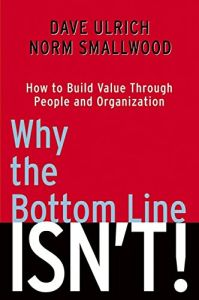Join getAbstract to access the summary!

Join getAbstract to access the summary!
Dave Ulrich and Norm Smallwood
Why the Bottom Line Isn't!
How to Build Value Through People and Organizations
Wiley, 2003
What's inside?
Your company’s intangible assets — talent, culture, knowledge — are as real as your balance sheet.
Recommendation
Authors Dave Ulrich and Norm Smallwood use a bottom-line approach to assess various business intangibles that build actual value, such as a vision of future growth and improved capabilities. They present the keys to creating value by mustering intangible assets in a well-organized, highly structured way. Unfortunately, the intangible factors and the growth steps they discuss are well-traveled territory. But while other books may describe how to develop these "soft" qualities in a more intriguing or more original way, this volume handily dissects, quantifies and explains them step by step. Here, the vague is made concrete. Even a bean counter could understand the bottom line value of innovation, improved internal systems and enhanced organizational culture with this explanation. getAbstract.com recommends it to those who want to invest in intangible assets in a tangible setting, for very tangible reasons.
Summary
About the Authors
David Ulrich, Ph.D., has co-authored ten books and more than 100 articles on management and has consulted with more than half of the Fortune 200 companies. He is on leave as a professor at the University of Michigan to serve as Mission President for the Church of Jesus Christ of Latter-Day Saints in Montreal. Norm Smallwood is cofounder of Results-Based Leadership and the co-author, with Ulrich, of Results-Based Leadership: How Leaders Build the Business and Improve the Bottom Line. He provides consulting services based on that book and this one.






















Comment on this summary